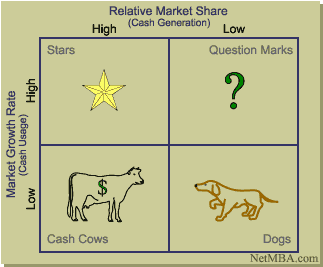Strategic Management > BCG Matrix
The BCG Growth-Share Matrix
The BCG Growth-Share Matrix is a portfolio planning model developed by Bruce Henderson of the Boston Consulting Group in the early 1970's. It is based on the observation that a company's business units can be classified into four categories based on combinations of market growth and market share relative to the largest competitor, hence the name "growth-share". Market growth serves as a proxy for industry attractiveness, and relative market share serves as a proxy for competitive advantage. The growth-share matrix thus maps the business unit positions within these two important determinants of profitability.
BCG Growth-Share Matrix

This framework assumes that an increase in relative market share will result in an increase in the generation of cash. This assumption often is true because of the experience curve; increased relative market share implies that the firm is moving forward on the experience curve relative to its competitors, thus developing a cost advantage. A second assumption is that a growing market requires investment in assets to increase capacity and therefore results in the consumption of cash. Thus the position of a business on the growth-share matrix provides an indication of its cash generation and its cash consumption.
Henderson reasoned that the cash required by rapidly growing business units could be obtained from the firm's other business units that were at a more mature stage and generating significant cash. By investing to become the market share leader in a rapidly growing market, the business unit could move along the experience curve and develop a cost advantage. From this reasoning, the BCG Growth-Share Matrix was born.
The four categories are:
Dogs - Dogs have low market share and a low growth rate and thus neither generate nor consume a large amount of cash. However, dogs are cash traps because of the money tied up in a business that has little potential. Such businesses are candidates for divestiture.
Question marks - Question marks are growing rapidly and thus consume large amounts of cash, but because they have low market shares they do not generate much cash. The result is a large net cash consumption. A question mark (also known as a "problem child") has the potential to gain market share and become a star, and eventually a cash cow when the market growth slows. If the question mark does not succeed in becoming the market leader, then after perhaps years of cash consumption it will degenerate into a dog when the market growth declines. Question marks must be analyzed carefully in order to determine whether they are worth the investment required to grow market share.
Stars - Stars generate large amounts of cash because of their strong relative market share, but also consume large amounts of cash because of their high growth rate; therefore the cash in each direction approximately nets out. If a star can maintain its large market share, it will become a cash cow when the market growth rate declines. The portfolio of a diversified company always should have stars that will become the next cash cows and ensure future cash generation.
Cash cows - As leaders in a mature market, cash cows exhibit a return on assets that is greater than the market growth rate, and thus generate more cash than they consume. Such business units should be "milked", extracting the profits and investing as little cash as possible. Cash cows provide the cash required to turn question marks into market leaders, to cover the administrative costs of the company, to fund research and development, to service the corporate debt, and to pay dividends to shareholders. Because the cash cow generates a relatively stable cash flow, its value can be determined with reasonable accuracy by calculating the present value of its cash stream using a discounted cash flow analysis.
Under the growth-share matrix model, as an industry matures and its growth rate declines, a business unit will become either a cash cow or a dog, determined soley by whether it had become the market leader during the period of high growth.
While originally developed as a model for resource allocation among the various business units in a corporation, the growth-share matrix also can be used for resource allocation among products within a single business unit. Its simplicity is its strength - the relative positions of the firm's entire business portfolio can be displayed in a single diagram.
Limitations
The growth-share matrix once was used widely, but has since faded from popularity as more comprehensive models have been developed. Some of its weaknesses are:
Market growth rate is only one factor in industry attractiveness, and relative market share is only one factor in competitive advantage. The growth-share matrix overlooks many other factors in these two important determinants of profitability.
The framework assumes that each business unit is independent of the others. In some cases, a business unit that is a "dog" may be helping other business units gain a competitive advantage.
The matrix depends heavily upon the breadth of the definition of the market. A business unit may dominate its small niche, but have very low market share in the overall industry. In such a case, the definition of the market can make the difference between a dog and a cash cow.
While its importance has diminished, the BCG matrix still can serve as a simple tool for viewing a corporation's business portfolio at a glance, and may serve as a starting point for discussing resource allocation among strategic business units.
Strategic Management > BCG Matrix


